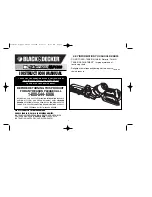
WARNING:
Do not let comfort or familiarity with the product replace strict adherence to product safety
rules. If you use this tool unsafe or incorrectly, you can suffer serious personal injury.
1. WORK ENVIRONMENT. Do not operate the tool in wet or damp conditions; doing so significantly increases
the risk of electrical shock. Do not operate the tool in the presence of flammable liquids or gases. When operating
the tool from an elevated position, be aware of people or things beneath you.
2. PERSONAL SAFETY. Always wear ANSI Z87.1-approved glasses, a dust mask and hearing protection when
using the saw. Do not wear loose clothing or jewelry as they might get drawn in by the tool.
3. PREVENTING ELECTRIC SHOCK. When working with the tool, make sure to keep the blade away from
any power cables, extension cords or wiring. Only hold the tool by insulated gripping surfaces when performing an
operation in case the cutter contacts its own cord. Cutting a “live” wire may make exposed metal parts of the tool
“live” and could give the operator an electric shock.
4. INSPECT YOUR TOOL BEFORE OPERATION. Before operation, check the tool for any damage or miss-
ing parts. Do not use the tool if any part is missing or damaged. Do not use the tool if the power switch is faulty, the
plug or cable is damaged, or the tool produces sparks, smoke, or unpleasant odors (you may smell brushes wearing
down for a few minutes as the tool breaks in during the first use, that is normal). Make sure all adjustments are cor-
rect and all connections are tight.
5. LOWER BLADE GUARD SAFETY. Check lower blade guard for functionality before each use. To check the
lower guard, unplug the tool and open the lower guard by lifting the blade guard lever, then release and watch the
guard close. Do not operate saw if lower guard does not move freely or close immediately. Leaving a blade exposed
is very dangerous and can lead to serious personal injury.
• Never clamp, tie, or otherwise fix the lower guard into the open position.
• If the saw is accidentally dropped, the lower guard may bend. Raise the lower guard with the blade guard lever to
make sure it moves freely without touching the blade or any other saw part for all angles and depths of possible cuts.
• Always ensure that the lower guard is covering the blade before placing the saw down on a bench or floor. An
unprotected, coasting blade will cause the saw to walk backwards, cutting whatever is in its path. Be aware of the time
it takes for the blade to stop after the switch is released.
• The lower guard should be retracted manually only for special cuts such as plunge cuts/pocket cuts (see page
14). Raise the lower guard by retracting the lever. As soon as the blade enters the material, the lower guard must be
released. For all other sawing, the lower guard should operate automatically.
6. SUPPORTING THE WORKPIECE. Never hold a piece being cut in your hands or across your legs. It is im-
portant to support the work properly to minimize body exposure, blade binding, or loss of control.
7. STARTING THE TOOL. Always start the saw before the blade comes into contact with the workpiece. Let the
blade reach full speed before using the tool. The reaction to the torque as the motor accelerates to full speed may
cause the tool to kick back.
8. STANDING POSITION. Keep your body positioned to either side of the saw blade, but not in line with the saw
blade. Kickback could cause the saw to jump backwards.
SPECIFIC RULES FOR THE CIRCULAR SAW
6
Summary of Contents for 36725
Page 18: ...18 EXPLODED VIEW PARTS LIST ...
Page 20: ...THANKS FOR REMEMBERING ...






































